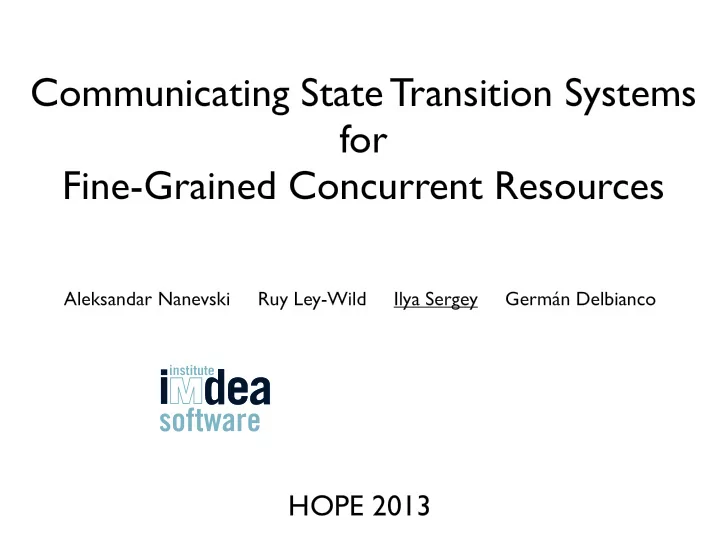

Acquire Transitions Intuition: the lock obtains back ownership over the heap and increments the service counter ( owner )
Acquire Transitions Intuition: the lock obtains back ownership over the heap and increments the service counter ( owner ) owner 7! n 1 ∗ next 7! n 2 ∗ ( a o , t o ) ` ⇣ ( a s , t s ∪ { n 1 } ) emp h true i ⇓ acq h 1 owner 7! n 1 + 1 ∗ next 7! n 2 ∗ ( a o , t o ) ( a s , t s ) ` ⇣ h h false i
Acquire Transitions Intuition: the lock obtains back ownership over the heap and increments the service counter ( owner ) owner 7! n 1 ∗ next 7! n 2 ∗ ( a o , t o ) ` ⇣ ( a s , t s ∪ { n 1 } ) emp h true i ⇓ acq h 1 owner 7! n 1 + 1 ∗ next 7! n 2 ∗ ( a o , t o ) ( a s , t s ) ` ⇣ h h false i
Acquire Transitions Intuition: the lock obtains back ownership over the heap and increments the service counter ( owner ) owner 7! n 1 ∗ next 7! n 2 ∗ ( a o , t o ) ` ⇣ ( a s , t s ∪ { n 1 } ) emp h true i ⇓ acq h 1 owner 7! n 1 + 1 ∗ next 7! n 2 ∗ ( a o , t o ) ( a s , t s ) ` ⇣ h h false i
Release Transitions Intuition: the lock gave up ownership over the heap
Release Transitions Intuition: the lock gave up ownership over the heap owner 7! n 1 ∗ next 7! n 2 ∗ ( a o , t o ) ` ⇣ ( a s , t s ∪ { n 1 } ) h h false i ⇓ rel h 1 owner 7! n 1 ∗ next 7! n 2 ∗ ( a o , t o ) ` ⇣ ( a s , t s ∪ { n 1 } ) emp h true i
Release Transitions Intuition: the lock gave up ownership over the heap owner 7! n 1 ∗ next 7! n 2 ∗ ( a o , t o ) ` ⇣ ( a s , t s ∪ { n 1 } ) h h false i ⇓ rel h 1 owner 7! n 1 ∗ next 7! n 2 ∗ ( a o , t o ) ` ⇣ ( a s , t s ∪ { n 1 } ) emp h true i
Release Transitions Intuition: the lock gave up ownership over the heap owner 7! n 1 ∗ next 7! n 2 ∗ ( a o , t o ) ` ⇣ ( a s , t s ∪ { n 1 } ) h h false i ⇓ rel h 1 owner 7! n 1 ∗ next 7! n 2 ∗ ( a o , t o ) ` ⇣ ( a s , t s ∪ { n 1 } ) emp h true i
Transitions don’t change the other part!
Transitions don’t change the other part! Transitions = Guarantee
Transposing the Concurroid owner 7! n 1 ∗ next 7! n 2 ( a s , t s ) ∗ ( a o , t o ) ` ⇣ h h b i
Transposing the Concurroid owner 7! n 1 ∗ next 7! n 2 ( a o , t o ) ∗ ( a s , t s ) ` ⇣ h h b i
Transposing the Concurroid owner 7! n 1 ∗ next 7! n 2 ( a o , t o ) ∗ ( a s , t s ) ` ⇣ h h b i Transitions of transposed = Rely
Transposing the Concurroid owner 7! n 1 ∗ next 7! n 2 ( a o , t o ) ∗ ( a s , t s ) ` ⇣ h h b i Transitions of transposed = Rely reminiscent to tokens by Turon et al. [POPL’13, ICFP’13]
Composing Concurroids
Intuition: Connect communication channels with right polarity
Intuition: Connect communication channels with right polarity ` ⇣ p ⇣
Intuition: Connect communication channels with right polarity rel acq ` ⇣ p ⇣ rel rel acq rel acq acq • Some channels might be left loose • Same channels might be connected several times • Some channels might be shut down
Entanglement Operators ⋈ , ⋊ , ⋉ , × ... Connect two concurroids by connecting some of their acquire/release transitions.
Entanglement Operators ⋈ , ⋊ , ⋉ , × ... Connect two concurroids by connecting some of their acquire/release transitions. Connected A/R transitions become internal for the entanglement.
Useful Entanglement Operators × - “apart”, doesn’t connect channels, leaves all loose. - connects all channels pair-wise, ⋊ shuts channels of the right operand, leaves left one’s loose
Useful Entanglement Operators × - “apart”, doesn’t connect channels, leaves all loose. - connects all channels pair-wise, ⋊ shuts channels of the right operand, leaves left one’s loose Lemma : U ⋊ (V 1 × V 2 ) = ( U ⋊ V 1 ) ⋊ V 2
Programming with Concurroids
Transitions are not yet commands!
Transitions are not yet commands! They only describe some correct behavior.
Atomic Actions • Defined as subsets of internal transitions • Specify the result • Operational meaning: READ , WRITE , SKIP and various RMW-commands • Synchronize ownership transfer and manipulation with auxiliaries
Recap: TLock Implementation lock = { x := DRAW; while (!TRY(x)) SKIP; } unlock = { INCR_OWN; }
Recommend
More recommend